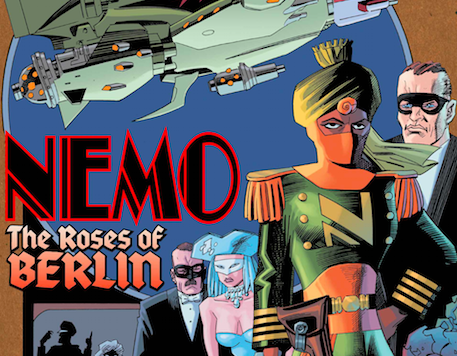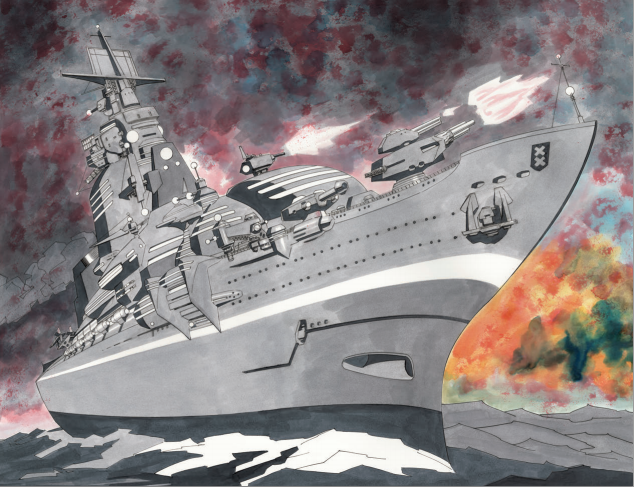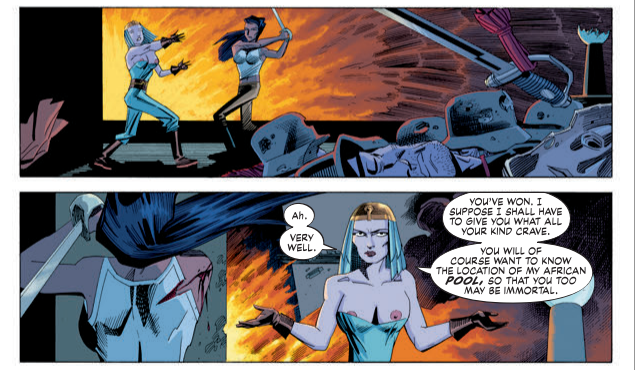The world of The League of Extraordinary Gentlemen gets a dark and dystopian twist in Top Shelf and Knockabout’s Nemo: The Roses of Berlin, the second 56-page hardcover spin-off, following last year’s Nemo: Heart of Ice. Captain Nemo leaves the sea for a journey into the dark heart of a futuristic Berlin in another satisfying chapter in Alan Moore and Kevin O’Neill’s long running adventure series.
Sixteen years after encountering Lovecraftian horror in Antarctica, Janni Dakkar—the second Captain Nemo—learns that her daughter Hira has been captured by Adenoid Hynkel (Charlie Chaplin’s Hitler stand-in from The Great Dictator). Janni and her lover Broad Arrow Jack attack Berlin to rescue her, but make many frightful encounters along the way, including the remnants of Berlin’s “Twilight Heroes” and an old foe who wants revenge on Janni.
Unlike League of Extraordinary Gentleman: Century, which was fascinating but at times impenetrable and wildly self-indulgent, Nemo: Roses of Berlin is a briskly-paced and straightforward adventure story. Janni and Jack have their mission—rescue Hira and crush anyone in Berlin who stands in their way—and they see it through to the bloody and explosive end.
The Roses of Berlin may not have the density of Moore’s best work, but it successfully delivers thrills and surprises. There are no lavish, experimental breaks in style like pages written in iambic pentameter or that need to be read with 3-D glasses, which may be a relief to some readers or a disappointment to others. Moore’s writing is at its most unobtrusive (aside from multiple pages written entirely in German) and the story finds most of its power in Kevin O’Neill’s visuals rather than Moore’s dialogue.
Kevin O’Neill’s artwork is particularly important because Nemo: Roses of Berlin is the most cinematic of the League books, taking its influence not from classic literature or penny dreadfuls, but German Expressionist film and the works of Fritz Lang in particular. This alternate history’s Berlin is the futuristic nightmare city of Metropolis, The Cabinet of Dr. Caligari, and The Testament of Dr. Mabuse; full of terrifying machines, impossible buildings, and mad-eyed men. The city is a character onto itself and O’Neill’s work is striking. However, one jarring moment comes during an important fight scene, wherein a female character’s breasts burst out of her top and nearly ruins the scene’s dramatic impact. Commentary on how bustiers are lousy fighting attire, or just a gratuitous tit shot? Either way, unnecessary.
Janni Dakkar is one of the standout original characters in the League of Extraordinary Gentlemen‘s “All-media-ever exists at once” universe and I’m pleased that she’s the star of Moore and O’Neill’s expanding universe. She’s a fascinating legacy character, and just as we saw her conflict with her father, the original Captain Nemo, so we now see her conflict with her own child about what the Nemo name means. Is Janni a hero, a villain, or just a damn good pirate? In The Roses of Berlin, she’s all three; a complex and satisfying protagonist who’s worthy of admiration and terror. Long may she sail.
Nemo: The Roses of Berlin reaches comic shops March 19th but is available now on digital platforms including Comixology and Kindle.




